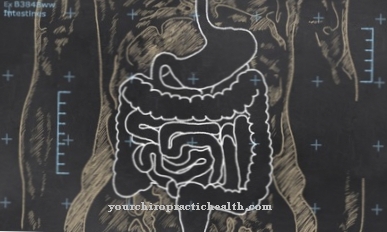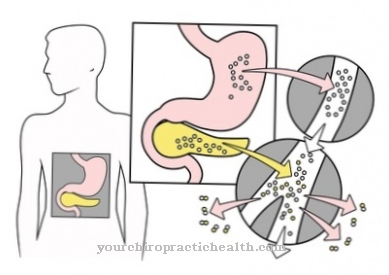Of the Location- or Sense of position is one of three perceptual qualities of interoceptive depth sensitivity. This sense provides permanent information on joint positions and the current body position in space. In the case of cerebellar and spinal cord lesions, the sense of position can be disturbed and thus cause ataxia.
What is the sense of position?

Humans perceive stimuli from their environment as well as from their own body. The reception of stimuli from the environment is summarized as exteroception. The perception of stimuli from one's own body is called interoception and corresponds to self-perception.
Deep sensitivity is one of the most important types of perception in the area of self-perception. Proprioceptors pick up stimuli from their own movement and holding apparatus and pass them on to the central nervous system.
The depth sensitivity can be broken down into three different perceptual qualities. The sense of strength and resistance, together with the sense of movement and the sense of position, form the so-called kinaesthetic system.
The sense of position is also called the sense of position or position sense and gives people a sense of their own body position. The sense provides comprehensive information on the current position of the body in space. This position information includes the positions of individual joints and the head. The interoceptors of deep sensitivity are the muscle spindles, the tendon spindles and the sensitive receptors of the joint capsules, ligaments and periosteum. Through these receptors, the sense of position creates a comprehensive picture of the body position and continuously projects it into consciousness.
Function & task
The senses of the kinesthetic system play closely together and are irreplaceable for other human senses. Together with the inner ear's sense of gravity, for example, they form an important basis for the sense of balance. Only the sense of position allows a person with an inclined head to develop an awareness of the current inclination. The sense of position is therefore indispensable in order to adopt a stable posture or to adapt the body position to changed environmental conditions.
Most proprioceptive afferents are unconscious. Smaller adjustments to the situation are made subconsciously, for example. The nervous system develops a sum from all proprioceptive afferents and in this way supplies an information product from the spatial body relationship, the position of individual limbs to one another and the change in position during movements to the central nervous system. Influences on the organism must be recognized permanently. The sensory information is selected there according to relevance and integrated with vestibular and optical information. In the sensory-motor integration of the stimuli, the development of targeted motor and cognitive functions takes place.
The receptors for the sense of position are mechanoreceptors in the joints, muscles and tendons. These sensory cells detect pressure and use these effects to calculate the position of the joints and the body, which is transmitted to the spinal cord as a bioelectrical impulse. The static sense of position recognizes the joint position in a body posture. The dynamic part of the sense of position, on the other hand, recognizes changes in body posture when moving.
Without the sense of position, no suitable interaction between sensory and motor stimulus processing would be possible. Targeted and exact movements would be subject to interference. Exteroception and interoception therefore play together in kinaesthetics.The brain is capable of kinaesthetic learning and saves, for example, specific body positions, environmental information and motor responses to adapt the body positions to one another, so that the next time it is possible to immediately initiate a suitable posture correction for certain environmental conditions.
You can find your medication here
➔ Medicines for paresthesia and circulatory disordersIllnesses & ailments
One of the best-known complaints related to position sense is hereditary motor-sensitive neuropathy. This is a classic, primarily axonal HMSN disease. Distally, the patients show symmetrical muscular atrophy and arches. They suffer from a reduced sense of vibration and a reduced sense of position. The disease is caused by mutations in the MED25 gene and is inherited in an autosomal recessive manner. The MED25 gene corresponds to a subunit of ARC known as the family of coactivators for transcription. The mutation has now been localized on chromosome 19q13.3.
All diseases that affect the sense of position are included in the group of deep sensitivity disorders. In addition to positional disorders, these include disorders of the sense of vibration and stereognosis. Apart from the hereditary and genetic diseases, such symptoms mainly occur after damage to the rear horns or the white matter. Such damage occurs, for example, in the context of traumatic injuries to the spine. Tumors in the spinal cord can also cause the lesions. The same is true for funicular spinal diseases.
Just as often the disorders described are preceded by a neurological disease such as multiple sclerosis. In this autoimmune disease, the immune system causes destructive inflammation in central nervous tissue.
The consequence of a deep sensitivity disorder caused by the spinal cord is spinal ataxia, which worsens especially in the dark. Spinal ataxias can also be triggered by vitamin B deficiency or poisoning and infectious diseases such as syphilis. An alcohol intoxication also triggers such ataxia, which is associated with the inability to coordinate movements and control posture.
Depression disorders can just as easily be caused by lesions in the cerebellum or disorders of the specific receptors in the Golgi tendon organs, the muscle spindles and joint receptors.
In all cases, the patients no longer correctly assess their own position in space. The result is an unconventional posture, a disturbed gait pattern and often the inability to make rapid agonist-antagonist movements. The treatment of such ataxias is based on occupational therapy and physiotherapy and is primarily intended to improve the patient's body awareness.












.jpg)



.jpg)










.jpg)
